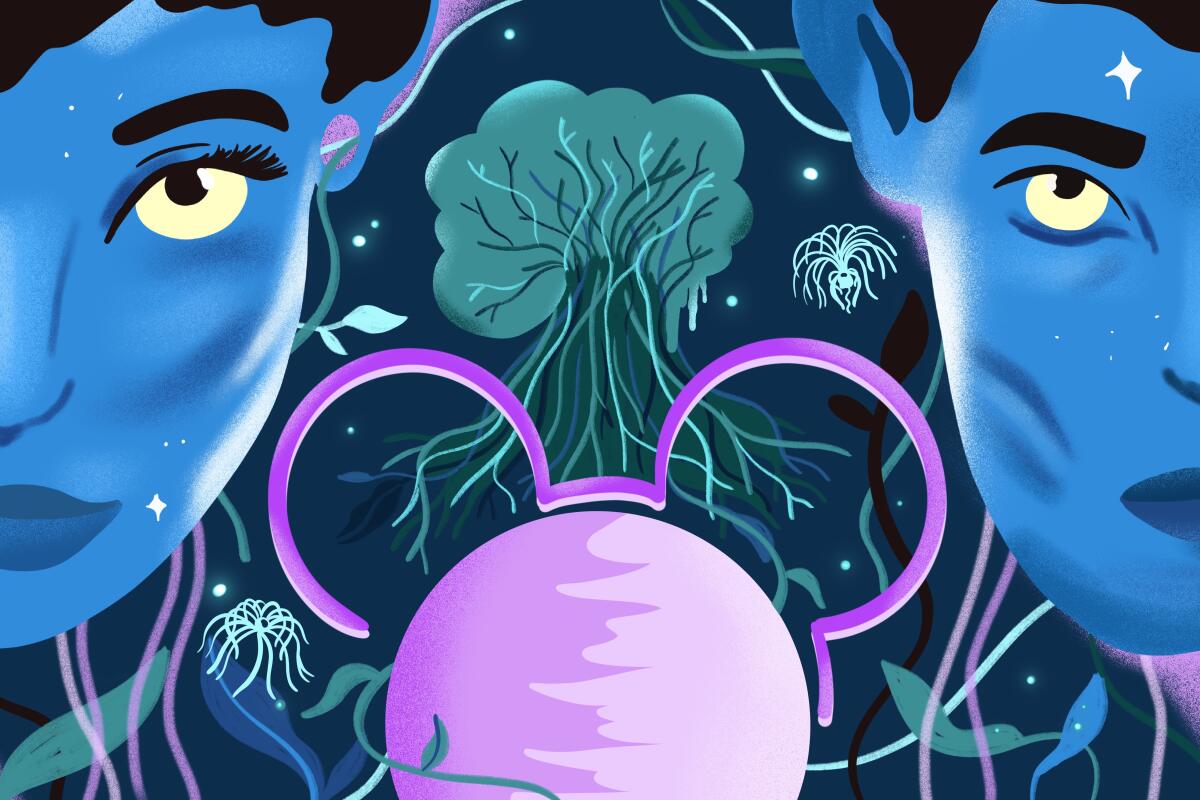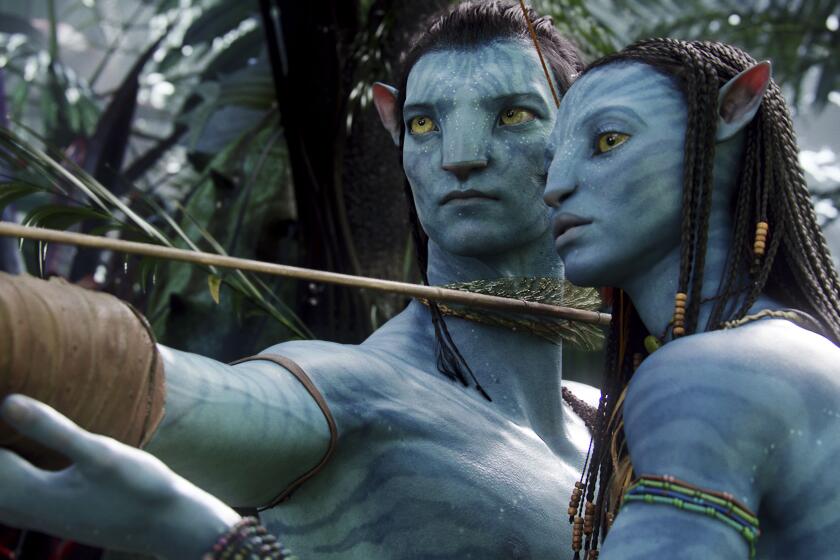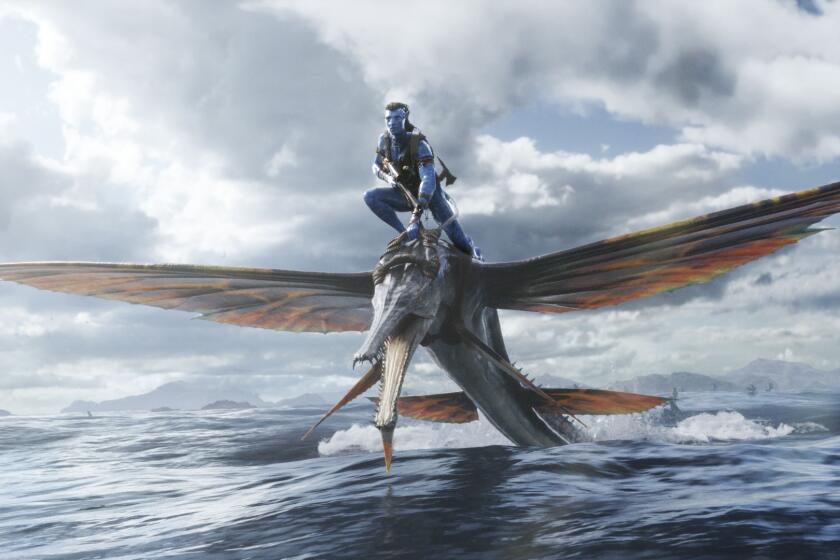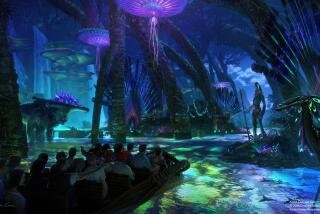How Disney kept the fire burning for ‘Avatar’ for 13 long years

- Share via
One criticism I’ve seen levied against “Avatar” in the 13 years since its release is that James Cameron’s 2009 film is the cinematic equivalent of a theme park. I suspect this is meant derisively — an indication that “Avatar” prizes spectacle over insight, thrills over emotion.
I also suspect these critics may not understand the appeal of a theme park.
It’s an open question whether “Avatar,” a groundbreaking technical achievement and box office phenomenon, established the kind of cultural footprint that can endure the long delay between the original and the release of its sequel, “Avatar: The Way of Water,” on Dec. 16. Are fans of the original all that desperate to find out what happened to Sam Worthington’s Jake Sully and Zoe Saldaña’s Neytiri? Will new viewers be won over by the unusual premise, in which Sully, a human, trades in his disabled body for a blue-skinned Na’vi avatar, thanks in no small part to falling in love?
But when I think of “Avatar” my mind doesn’t go to the film’s finer plot points or its box office records or its environmental themes. I think of Pandora.
Pandora is a marvelous cinematic world, a fairy-tale-inspired universe where plants glow, the ground comes alive with every Na’vi step and dragon-like creatures — their magnificent swirls brighter and bolder than a child’s kite — soar in the sky. It’s also a place that I learned I missed, not through constant rewatching of “Avatar,” but through, well, a theme park. And that connection with the universe of the film might explain how Disney and Cameron kept the fires of interest in a sequel burning for more than a decade.
As James Cameron’s 2009 megahit ‘Avatar’ heads back to theaters, Sam Worthington, Stephen Lang and Jon Landau revisit the epic and tease ‘Avatar 2.’
Walt Disney World’s Pandora: The World of Avatar made me realize I have plenty of interest in “Avatar’s” ecosystem — and without recourse to what I first saw onscreen in 2009. At Pandora, situated inside Walt Disney World’s Animal Kingdom park in Lake Buena Vista, Fla., there is no sign of Sully or Neytiri. Instead of re-creating scenes from the film or populating the park with characters from the movie, Disney’s Pandora, which opened in 2017, expands on the universe. You could even say it creates a sequel of sorts: Set about a generation after the conflict in the first film, the Pandora of the theme park is a postwar planet on the road to rehabilitation, emphasizing themes of conservation and exploration.
And explore we do.
The land has rides, of course, but they’re designed to create the illusion of a personal journey rather than retell cinematic myths. One, Avatar Flight of Passage, is a 3-D motion simulator meant to forge an individual connection with one of those colorful, dragon-like creatures known as the banshee. Its backdrop is one of perseverance, of a species in the process of repopulation, and it’s the rare theme park attraction that feels intimate. The ride’s personal, stationary-bike-like vehicles vibrate to mimic the movements of an animal — this is my banshee — and riders soar among Pandora’s floating mountains and through waterfalls, all of it cresting in the final act when the sounds of nature give way to a comforting musical score.
Even better, in my (unpopular) opinion, is the slower, tamer Na’vi River Journey. The short but languid boat attraction has guests drift calmly through a bioluminescent forest, culminating in a visit with the Shaman of Songs, a Na’vi woman who serenades riders as they pass by. Floating jellyfish creatures soar through the sky, wolf-like predators trot off in the distance and other four-legged creatures puff up their feathers as guests roll past. The ride’s sole purpose is to place us in a world of wonder and beauty, mimicking the sort of expedition one might take when visiting an unfamiliar nature preserve.
Cameron unveiled about eight minutes of footage from the long-awaited ‘Avatar: The Way of Water’ during Disney’s expo Saturday. Here’s what to know.
Disney’s Pandora is also a place designed for guests to linger. The first time I visited, I stopped every few steps to take it all in. I stood on pavement that was painted to glow. Above me rose a mountainous rock that appeared to be floating. Nearby was a yellow-orange plant-like structure the size of a small car, one that, rubbed in a certain spot, would shower those standing near it with water. Surrounding me was nature — some man-made, some real — and the sensation that came from it could only be described as mystical. Pandora the theme park, like any film franchise worth returning to, is welcoming and familiar, yet just unknown enough to keep one adventuring, in search of the never-seen-before.
Visiting this real-life Pandora also changed the way I see the film. The militaristic aspects of the plot, with human raiders bent on destruction of the moon in order to harvest its natural resources, have over time faded into the background when I view “Avatar.” I forgive too its occasionally questionable politics, as many rightly view Sully as the embodiment of the “white savior” narrative cliché. What lingers instead is its vision and its focus on the power of the dreamer, the experience of longing for peace, the desire for everlasting love and the possibility of being in concert with nature.
Hokey, sure, but so is Disneyland’s Fantasyland, and that’s full of big themes and miniature life lessons — the work/life balance of a ride based on the film “Snow White and the Seven Dwarfs,” the temptation to give in to our vices that is Mr. Toad’s Wild Ride and the potential to hold on to youthful idealism forever seen in Peter Pan’s Flight. The best theme park rides are, not unlike movies, visual poems, works that take big swings at the harsh realities of our lives while believing there is a better, more triumphant version out there as well. Only their 3-D is more convincing than even the most state-of-the-art Imax.
“Avatar” is an emblem of that ambition. It’s one likely reason it became a blockbuster in the first place. In recent months, stories have begun to recirculate of audience members for the original film experiencing depression after taking in — and having to leave — the beauty of Pandora. They spoke not of the film’s narrative rhythms but of being wholly transported by it — similar to what many say after visiting a Disney or Universal theme park.
The connection we feel with such places doesn’t come from a love of intellectual property or even the smell of a churro, after all. It’s their reminder that the best stories are often the ones that give us the tools to imagine ourselves inside them.
More to Read
Only good movies
Get the Indie Focus newsletter, Mark Olsen's weekly guide to the world of cinema.
You may occasionally receive promotional content from the Los Angeles Times.













